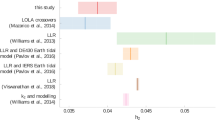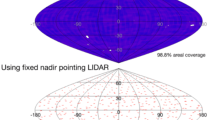Abstract
The Ganymede Laser Altimeter (GALA) is one of the ten scientific instruments selected for the Jupiter Icy Moons Explorer (JUICE) mission currently implemented under responsibility of the European Space Agency (ESA). JUICE is scheduled for launch in mid 2022; arrival at Jupiter will be by end of 2029 with the nominal science mission—including close flybys at Ganymede, Europa, and Callisto and a Ganymede orbit phase—ending by mid 2033. GALA’s main objective is to obtain topographic data of the icy satellites of Jupiter: Europa, Ganymede, and Callisto. By measuring the diurnal tidal deformation of Ganymede, which crucially depends on the decoupling of the surface ice layer from the deep interior by a liquid water ocean, GALA will obtain evidence for (or against) a subsurface ocean in a 500 km orbit around the satellite and will provide constraints on Ganymede’s ice shell thickness. In combination with other instruments, it will characterize the morphology of surface units on Ganymede, Europa, and Callisto providing not only topography but also surface roughness and albedo (at 1064 nm) measurements. GALA is a single-beam laser altimeter operating with up to 50 Hz (nominal 30 Hz) shot frequency at a wavelength of 1064 nm and pulse lengths of \(5.5\pm 2.5\) ns using a Nd:YAG laser. The return pulse is detected by an Avalanche Photo Diode (APD) with 100 MHz bandwidth and is digitized at a sampling rate of 200 MHz providing range measurements with a subsample resolution of 0.1 m and surface roughness measurements from pulse-shape analysis on the scale of the footprint size of about 50 m at 500 km altitude. The instrument is developed in collaboration of institutes and industry from Germany, Japan, Switzerland, and Spain.


Similar content being viewed by others
Abbreviations
- ADC:
-
Analog-to-digital converter
- AEM:
-
Analog electronics module
- APD:
-
Avalanche photo diode
- BELA:
-
BepiColombo laser altimeter
- BEO:
-
Back-end optics
- CDR:
-
Critical design review
- DC:
-
Direct current
- DPM:
-
Digital processing module
- ELU:
-
Electronics unit
- EM:
-
Engineering model
- EMC:
-
Electro-magnetic compatibility
- EMI:
-
Electro-magnetic interference
- EQM:
-
Engineering qualification model
- ESA:
-
European space agency
- FPA:
-
Focal-plane assembly
- FPGA:
-
Field programmable gate array
- GALA:
-
Ganymede laser altimeter
- JUICE:
-
Jupiter icy moons explorer
- LEU:
-
Laser electronics unit
- LHM:
-
Laser head module
- MLI:
-
Multilayer insulation
- M1:
-
Main mirror
- M2:
-
Secondary mirror
- MOS:
-
Metal-oxide semiconductor
- Nd:YAG:
-
neodymium-doped yttrium aluminum garnet, \(\hbox {Nd:Y}_3\hbox {Al}_5\hbox {O}_{12}\)
- PCM:
-
Power converter module
- PFM:
-
Proto flight model
- RFM:
-
Range finder module
- RX:
-
Receiver
- RXM:
-
Receiver module
- STM:
-
Structural and thermal model
- TEL:
-
Receiver telescope
- TID:
-
Total ionizing dose
- TRU:
-
Transceiver unit
- TX:
-
Transmitter
References
Althaus, C., Michaelis, H., Hussmann, H., Lingenauber, K., Kallenbach, R., Del Togno, S., Lüdicke, F.: BELA transmitter performance and pointing stability verification campaign at DLR-PF. Acta Astronaut. 154, 103–118 (2019)
Anderson, J.D., Lau, E.L., Sjogren, W.L., Schubert, G., Moore, W.B.: Gravitational constraints on the internal structure of Ganymede. Nature 384, 541–543 (1996)
Araki, H., Tazawa, S., Noda, H., Ishihara, Y., Goossens, S., Sasaki, S., Kawano, N., Kamiya, I., Otake, H., Oberst, J., Shum, C.: Lunar global shape and polar topography derived from Kaguya-LALT Laser altimetry. Science 323, 897–900 (2009)
Bagenal, F., Dowling, T.E., McKinnon, W.B. (Eds.): Jupiter, pp. 748. ISBN 0521818087. Cambridge University Press, Cambridge (2004)
Boutonnet, A., Varga, G.: JUICE—Jupiter icy moons explorer consolidated report on mission analysis (CReMA), Version 3.1, Technical Note, ESA (2016)
Daly, M.G., et al.: The OSIRIS-REx laser altimeter (OLA) investigation and instrument. Space Sci. Rev. 212, 899–924 (2017)
Giese, B., Oberst, J., Roatsch, T., Neukum, G.: DLR, institute of planetary exploration J. W. Head and R. T. Pappalardo: the local topography of Uruk Sulcus and Galileo Regio Obtained from stereo images. Icarus 135, 303–316 (1998)
Grasset, O., et al.: JUpiter ICy moons Explorer (JUICE): an ESA mission to orbit Ganymede and to characterise the Jupiter system. Planet. Space Sci. 78, 1–21 (2013)
Hussmann, H., Shoji, D., Steinbrügge, G., Stark, A., Sohl, F.: Constraints on dissipation in the deep interiors of ganymede and Europa from tidal phase-lags. Cel. Mech. Dyn. Astr. 126, 131–144 (2016)
Khurana, K.K., Kivelson, M.G., Stevenson, D.J., Schubert, G., Russel, C.T., Walker, R.J., Polanskey, C.: Induced magnetic fields as evidence for subsurface oceans in Europa and Callisto. Nature 395, 777–780 (1998)
Kimura, J., Hussmann, H., Kamata, S., Matsumoto, K., Oberst, J., Steinbrügge, G., Stark, A., Gwinner, K., Oshigami, S., Namiki, N., Lingenauber, K., Enya, K., Kuramoto, K., Sasaki, S.: Science objectives of the ganymede laser altimeter (GALA) for the JUICE mission. Trans. JSASS Aerosp. Tech. Japan 17, 234–243 (2019)
Kivelson, M.G., Khurana, K.K., Volwerk, M.: The permanent and inductive magnetic moments on Ganymede. Icarus 157, 507–522 (2002)
Li, C., et al.: Laser altimetry data of Chang’E-1 and the global lunar DEM model. Sci. China Earth Sci. 53, 1582–1593 (2010)
Moore, W.B., Schubert, G.: The tidal response of Ganymede and Callisto with and without liquid water oceans. Icarus 166, 223–226 (2003)
Mukai, T., et al.: An overview of the LIDAR observations of asteroid 25143 Itokawa. Adv. Space Res. 40, 187–192 (2007)
Anderson, J.J.D., Schubert, G., Moore, W.B.: Mass anomalies on ganymede: palguta. Icarus 180, 428–441 (2006)
Pappalardo, R. T., Collins, G.C., Head III, J. W., Helfenstein, P., McCord, T.B., Moore, J.M., Prockter, L.M., Schenk, P.M., Spencer, J.R.: Geology of Ganymede. In: Jupiter: The planet, satellites and magnetosphere, Bagenal, F., Dowling, T. E. and McKinnon, W. B., Eds., Cambridge University Press, pp. 363–396 (2004)
Schubert, G., Anderson, J.D., Spohn, T., McKinnon, W.B.: Interior composition, structure and dynamics of the Galilean satellites. In: Jupiter: The planet, satellites and magnetosphere, Bagenal, F., Dowling, T.E., McKinnon, W.B., Eds., Cambridge University Press, pp. 281–306 (2004)
Singer, K.N., Bland, M.T., Schenk, P.M., McKinnon, W.B.: Relaxed impact craters on Ganymede: Regional variation and high heat flows. Icarus 306, 214–224 (2018)
Smith, D.E., et al.: Mars Orbiter Laser Altimeter: experiment summary after the first year of global map** of Mars. J. Geophys. Res. 106(E10), 23689–23722 (2001)
Smith, D.E., et al.: The lunar orbiter laser altimeter investigation on the lunar reconnaissance orbiter mission. Space Sci. Rev. 150, 209–241 (2010a)
Smith, D.E., et al.: The equatorial shape and gravity field of Mercury from MESSENGER flybys 1 and 2. Icarus 209, 88–100 (2010b)
Smith, D.E., et al.: Summary of the results from the lunar orbiter laser altimeter after seven years in lunar orbit. Icarus 283, 70–91 (2017)
Spohn, T., Schubert, G.: Oceans in the icy Galilean satellites of Jupiter? Icarus 161, 456–467 (2003)
Sohl, F., Spohn, T., Breuer, D., Nagel, K.: Implications from galileo observations on the interior structure and chemistry of the galilean satellites. Icarus 157, 104–119 (2002)
Steinbrügge, G., Stark, A., Hussmann, H., Sohl, F., Oberst, J.: Measuring tidal deformations by laser altimetry. A performance model for the Ganymede Laser Altimeter. Planet. Space Sci. 117, 184–191 (2015)
Steinbrügge, G., Steinke, T., Thor, R., Stark, A., Hussmann, H.: Measuring ganymede’s librations with laser altimetry. Geosciences 9, 320 (2019)
Susorney, H.C.M., Barnouin, O.S., Ernst, C.M., Byrne, P.K.: The surface roughness of mercury from the mercury laser altimeter: investigating the effects of volcanism, tectonism, and impact cratering. J. Geophys. Res. (Planets) 22, 1372–1390 (2017)
Thomas, N., et al.: The BepiColombo Laser Altimeter (BELA): concept and baseline design. Planet. Space Sci. 55, 1398–1413 (2007)
Turcotte, D.L., Schubert, G.: Geodynamics. Cambridge University Press, Cambridge (2002)
Zuber, M.T., Smith, D.E., Lemoine, F.G., Neumann, G.A.: The shape and internal structure of the moon from the clementine mission. Science 266, 1839–1843 (1994)
Zuber, M.T., et al.: Internal structure and early thermal evolution of mars from mars global surveyor topography and gravity. Science 287, 1788–1793 (2000a)
Zuber, M.T., et al.: The shape of 433 Eros from the NEAR-shoemaker laser rangefinder. Science 289, 2097–2101 (2000b)
Zuber, M.T., et al.: Topography of the Northern hemisphere of Mercury from MESSENGER laser altimetry. Science 336, 217–220 (2012)
Acknowledgements
The authors would like to thank two anonymous reviewers for their helpful comments on a first version of the manuscript. Financial support was provided under grant 50 QJ 1401 on behalf of the DLR Space Administration by the German Bundesministerium für Wirtschaft und Energie. This research has been supported by the Spanish Ministerio de Economía y Competitividad under Contract ESP 2016–76076–R.
Author information
Authors and Affiliations
Corresponding author
Additional information
Publisher’s Note
Springer Nature remains neutral with regard to jurisdictional claims in published maps and institutional affiliations.
Rights and permissions
About this article
Cite this article
Hussmann, H., Lingenauber, K., Kallenbach, R. et al. The Ganymede laser altimeter (GALA): key objectives, instrument design, and performance. CEAS Space J 11, 381–390 (2019). https://doi.org/10.1007/s12567-019-00282-8
Received:
Revised:
Accepted:
Published:
Issue Date:
DOI: https://doi.org/10.1007/s12567-019-00282-8




